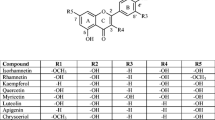Abstract
The 13C NMR chemical shifts of a range of flavonoids are predicted by the Mnova NMRPredict software and related to their radical scavenging activity (RSA). 13C NMR chemical shifts of C atoms bearing phenolic OH groups associated with radical attack tend to decrease with increasing antiradical activity. For a data set of 27 flavonoids, fair correlation (r = −0.881) was found between the antiradical activity and minimal value of the 13C NMR chemical shift (NMR min), and it was similar to the correlation (r = −0.850) obtained with the minimal O–H bond dissociation enthalpy (BDE min) calculated by the PM7 method. For a particular flavonoid molecule, 13C NMR chemical shifts of C atoms bearing phenolic OH groups correlate nicely with the corresponding O–H BDEs (e.g., for robinetin r = 0.953). For the complete data set, there is a similar correlation between NMR min and BDE min values (r = 0.944). As a rule, NMR min is related to nuclei bearing a 3′,4′-dihydroxy moiety in the B ring or 3-OH phenolic group in the C ring, i.e., to the preferred sites of radical attack. Thus, the 13C NMR chemical shifts of C atoms bearing phenolic OH groups are in accordance with the O–H BDEs, i.e., describe the H atom donor ability of phenolic OH groups. The statistical significance of the relationship between the minimal 13C NMR chemical shift and RSA was verified by comparison with correlations between RSA and each of 1,140 Dragon molecular descriptors, where the highest correlation coefficient of 0.812 was obtained.
Graphical abstract





Similar content being viewed by others
References
Halliwell B (2009) Free Radic Biol Med 46:531
Havsteen BH (2002) Pharmacol Ther 96:67
Williams RJ, Spencer JPE, Rice-Evans C (2004) Free Radic Biol Med 36:838
Cazarolli LH, Zanatta L, Alberton EH, Figueiredo MSRB, Folador P, Damazio RG, Pizzolatti MG, Silva FRMB (2008) Mini Rev Med Chem 8:1429
Bors W, Heller W, Michel C, Saran M (1990) Flavonoids as antioxidants: determination of radical-scavenging efficiencies. In: Packer L, Glazer AN (eds) Methods in enzymology, vol 186. Academic Press, San Diego, p 343
Amić D, Davidović-Amić D, Bešlo D, Rastija V, Lučić B, Trinajstić N (2007) Curr Med Chem 14:827
Zhang H-Y, Ji H-F (2006) New J Chem 30:503
Litwinienko G, Ingold KU (2007) Acc Chem Res 40:222
Apak R, Gorinstein S, Böhm V, Schaich KM, Özyürek M, Güclü K (2013) Pure Appl Chem 85:957
Amić D, Lučić B (2010) Bioorg Med Chem 18:28
Prabhakar YS, Gupta MK (2008) Sci Pharm 76:101
Fossen T, Andersen ØM (2006) Spectroscopic techniques applied to flavonoids. In: Andersen ØM, Markham KR (eds) Flavonoids: chemistry, biochemistry and applications. CRC Press, Boca Raton, p 37
March R, Brodbelt J (2008) J Mass Spectrom 43:1581
Agrawal PK (1989) Carbon-13 NMR of Flavonoids. Elsevier, Amsterdam
Ternai B, Markham KR (1976) Tetrahedron 32:565
Markham KR, Ternai B (1976) Tetrahedron 32:2607
Markham KR, Ternai B, Stanley R, Geiger H, Mabry TJ (1978) Tetrahedron 34:1389
Agrawal PK, Schneider H-J (1983) Tetrahedron Lett 24:177
Markham KR, Sheppard C, Geiger H (1987) Phytochemistry 26:3335
Wawer I, Zielinska A (1997) Solid State NMR 10:33
Wawer I, Zielinska A (2001) Magn Reson Chem 39:374
Park Y, Moon B-H, Lee E, Lee Y, Yoon Y, Ahn J-H, Lim Y (2007) Magn Reson Chem 45:674
Burns DC, Ellis DA, March RE (2007) Magn Reson Chem 45:835
Zhou X, Peng J, Fan G, Wu Y (2005) J Chromatogr A 1092:216
Lee S, Park Y, Moon B-H, Lee E, Hong S, Lim Y (2008) Bull Korean Chem Soc 29:1597
Price KR, Rhodes MJC (1997) J Sci Food Agric 74:331
Aksnes DW, Standnes A, Andersen ØM (1996) Magn Reson Chem 34:820
Moon B-H, Lee Y, Ahn J-H, Lim Y (2006) Magn Reson Chem 44:99
Verma RP, Hansch C (2011) Chem Rev 111:2865
Burda S, Oleszek W (2001) J Agric Food Chem 49:2774
Mestrelab Research, MNova Version: 5.2.5-4731, http://mestrelab.com
Zielinski R, Szymusiak H (2003) Pol J Food Nutr Sci 12/53:157
Musialik M, Kuzmicz R, Pawlowski TS, Litwinienko G (2009) J Org Chem 74:2699
Wright JS, Johnson ER, DiLabio GA (2001) J Am Chem Soc 123:1173
Košinova P, Di Meo F, Anouar EH, Duroux J-L, Trouillas P (2011) Int J Quantum Chem 111:1131
Stepanić V, Gall Trošelj K, Lučić B, Marković Z, Amić D (2013) Food Chem 141:1562
Amić D, Stepanić V, Lučić B, Marković Z, Dimitrić Marković JM (2013) J Mol Model 19:2593
Cobos CJ, Capparelli AL (1995) J Fluor Chem 70:155
Amić D, Davidović-Amić D, Bešlo D, Trinajstić N (2003) Croat Chem Acta 76:55
Armaković S, Armaković SJ, Šetrajčić JP, Šetrajčić IJ (2012) J Mol Model 18:4491
Talete srl, DRAGON 5.4, www.talete.mi.it
Claridge T (2009) J Chem Inf Model 49:1136
Stewart JJP (2013) J Mol Model 19:1
MOPAC2012. http://openmopac.net/MOPAC2012.html
Todeschini R, Consonni V (2000) Handbook of molecular descriptors. Wiley-VCH, Weinheim
Acknowledgments
This work was supported by grants 098-1770495-2919, 098-0982929-2917, 098-0982464-2511 and 079-0000000-3211 awarded by the Ministry of Science, Education and Sports of the Republic of Croatia. The authors thank Mestrelab Research S.L. for the free demonstration version of the MestReNova LITE program. We also gratefully acknowledge the anonymous reviewers for their constructive comments.
Author information
Authors and Affiliations
Corresponding authors
Electronic supplementary material
Below is the link to the electronic supplementary material.
Rights and permissions
About this article
Cite this article
Lučić, B., Stepanić, V., Plavšić, D. et al. Correlation between 13C NMR chemical shifts and antiradical activity of flavonoids. Monatsh Chem 145, 457–463 (2014). https://doi.org/10.1007/s00706-013-1130-4
Received:
Accepted:
Published:
Issue Date:
DOI: https://doi.org/10.1007/s00706-013-1130-4




